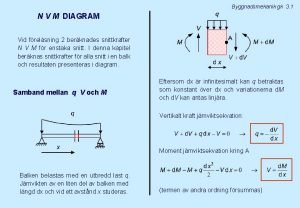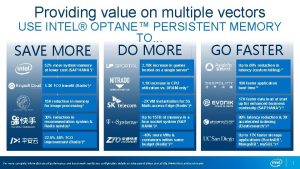Various NVM technologies The Intel Optane 3 D









- Slides: 9

• Various NVM technologies • The Intel Optane (3 D Xpoint)

Two types of interfaces for file systems: • POSIX • mmap/DAX-mmap Traditional file systems: • high speed page cache • data will be copied twice: The new NVMM-based file systems: • bypassing the page cache and • bypassing the block-based I/O softw stack.

a) Allocating a Mainbuffer in DRAM using malloc() b) Getting the VM address by mmap() to map the NVMM or disk space c) Initializing Mainbuffer d) Moving the Mainbuffer data from DRAM to Disk or NVMM by calling bcopy() e) Executing msync() to keep the data consistent

The flushing method traditional evaluation tools call msync() keep data consistent a) create a store barrier b) require the operating system to find dirty pages c) flush dirty pages to the disk However, for the NVMM-based file system: • • bypasses the page cache CPU can load/store NVMM directly by the mapping So, the operating system only needs to flush the CPU cache to write the changes to the NVMM Conveniently, Intel provides NVM libraries • • libpmemobj

Bypassing the CPU cache • For scenarios where data is only used once , passing CPU cache will bring some overhead • when data in the files are only processed once, pursuing for even higher performance with the DAX-mmap interface,

Experiment configuration • Optane DC persistent memory– NMA 1 XXD 128 GQS • Intel(R) Xeon(R) Platinum 8268 CPU @ 2. 90 GHz with cache size of 36608 KB • The DRAM is Micron with size of 128 GB

• With an average increase of 1. 4 times, and a maximum increase of 2. 1 times • The overhead of the traditional msync() will largely under-evaluate the real performance of the NVMM-based file system

• average 1. 7 times higher • For the scenarios of data used once, bypassing CPU cache is better

NVMFS-Iozone • Using the NVM-lib from Intel instead of traditional msync() for data consistency, improving the accuracy of the evaluation results. • Supporting the direct data path between CPU and NVMM without the interference of the Mainbuffer in DRAM and other software stacks. • . Adding the option of bypassing the CPU cache in the data path to support the evaluation of the new scenarios for NVMM-based file systems.
















